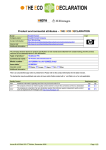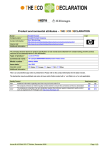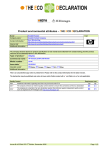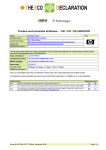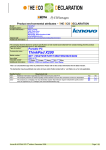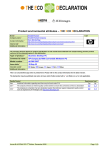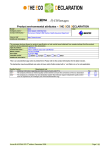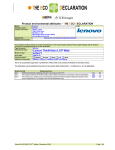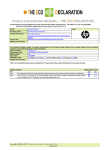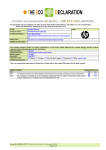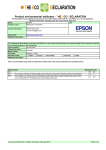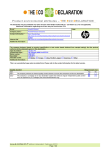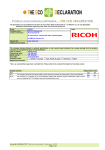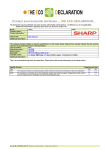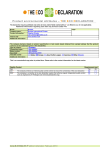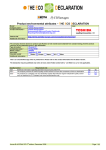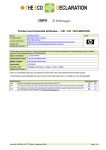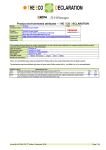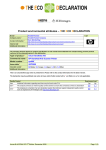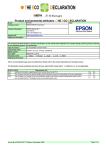Download HP ScanJet 8270 Document Flatbed Scanner IT Eco ECMA
Transcript
Product environmental attributes – THE ECO DECLARATION Brand * Hewlett-Packard Company name * Hewlett-Packard Company Hans Wendschlag http://www.hp.com/hpinfo/globalcitizenship/environment/contactemail.html Contact information * Internet site * Additional information Logo http://www.hp.com/hpinfo/globalcitizenship/environment/ The company declares (based on product specification or test results based obtained from sample testing), that the product conforms to the statements given in this declaration. Type of product * Scanner Commercial name * HP ScanJet 8270 Document Flatbed Scanner Model number * L1975A Issue date * April 2009 Intended market * Global Europe Japan U.S. Other Asia Pacific except Japan Additional information This is an uncontrolled copy when in printed form. Please refer to the contact information for the latest version. The declaration may be published only when all rows and/or fields marked with a * are filled-in (n.a. for not applicable). Quality Control Item Additional information regarding each item may be found under P14. QC1 * The company enforces an internal quality control scheme to ensure the correctness of this eco declaration QC2 * The company is a member of an eco declaration system that enforces regular independent quality control such as organized by IT-Företagen (see http://www.itforetagen.se). Annex B of ECMA-370 2nd Edition, December 2006 Requirement met Yes No Page 1 (5) Model number * L1975A Issue date * April 2009 Logo Product environmental attributes - Legal requirements Item Requirement met *=mandatory to fill in. Additional information regarding each item may be found under P14. P1 Hazardous substances and preparations P1.1* Products do not contain lead, cadmium, mercury, hexavalent chromium, polybrominated biphenyl (PBB) and polybrominated diphenyl ether (PBDE) as specified in EU 2002/95/EC and its amendments P1.2* Products do not contain Asbestos (EU 76/769/EEC, amendment 1999/77/EC) P1.3* Products do not contain Ozone Depleting Substances: Chlorofluorocarbons (CFC), hydrobromofluorocarbons (HBFC), hydrochlorofluorcarbons (HCFC), Halons, carbontetrachloride, 1,1,1-trichloroethane, methyl bromide (EU : Regulation (EC) No. 2037/2000, 2038/2000, 2039/2000) P1.4* Products do not contain polychlorinated biphenyl (PCB), polychlorinated terphenyl (PCT), (EU 76/769/EEC) P1.5* Products do not contain short chain chloroparaffins (SCCP) with 10-13 carbon atoms in the chain containing at least 48% per mass of chlorine in the SCCP as specified in Norwegian regulation relating to restrictions on the use of certain dangerous chemicals 20.12.2002 P1.6* Textile and leather parts with direct skin contact do not contain Tri-(2,3,-dibromopropyl)-phosphate (TRIS), Tris(aziridinyl)-phosphineoxide (TEPA), polybrominated biphenyl (PBB) (EU 76/769/EEC) P1.7* Textile and leather parts with direct skin contact do not contain Azo colourants that split aromatic amines as specified in EU 76/769/EEC, amendment 2003/3/EC P1.8* Wooden parts do not contain arsenic and chromium as a wood preservation treatment as well as pentachlorophenol and derivatives (EU 76/769/EEC) P1.9* Parts with direct and prolonged skin contact do not release nickel in concentrations higher than specified in 76/769/EEC, amendment 94/27/EEC P2 Batteries P2.1* If hazardous batteries (as defined in 91/157/EEC) are used in the product they are easily removable and labelled with the disposal and the substance logo (as defined in 91/157/EEC, 93/86/EEC) P2.2* If batteries are used in the product they do not contain mercury in concentrations higher than specified in 91/157/EEC P2.3* If batteries are permanently installed in the product, information on the environmentally hazardous substances and safe removal method is listed in the user manual (91/157/EEC) P3 Electrical safety, EMC and connection to the telephone network P3.1* The product meets the Low Voltage Directive (LVD) regarding electrical safety (73/23/EEC & 93/68/EEC) P3.2* The product meets the EMC Directive regarding electromagnetic compatibility (89/336/EEC / 2004/108/EEC th after June, 20 2007 P3.3* If product is intended for connection to a public telecom network or contains a radio transmitter, it meets the EU R&TTE Directive (1999/5/EC) P3.4* The product is CE-marked and a Declaration of Conformity is available (93/68/EEC) P4 Consumable materials P4.1* If a photo conductor (drum, belt etc.) is used in the product, it does not contain cadmium in concentrations higher than specified in (76/769/EEC and 91/338/EEC) P4.2* If ink/toner is used in the product, it does not contain cadmium in concentrations higher than specified in (76/769/EEC and 91/338/EEC) P4.3* If the ink/toner formulation/preparation is classified as hazardous according to EU Directive 1999/45/EC, and as amended, the product/packaging is labelled and a Material Safety Data Sheet (MSDS) in accordance with (99/45/EC & 2001/58/EC) is available. P5 Product packaging P5.1* The sum of the concentration levels of lead, cadmium, mercury, and hexavalent chromium present in packaging or packaging components does not exceed 0,01% by weight (94/62/EC). P5.2* Plastic packaging material is marked according to ISO 11469 referring ISO 1043.(97/129/EEC) P5.3* The product packaging material is free from CFC/HCFC. P6 Treatment information P6.1* Information for recyclers/treatment facilities (e.g. as requested by 2002/96/EC) is available. Annex B of ECMA-370 2nd Edition, December 2006 Yes No n.a. Page 2 (5) Model number * L1975A Issue date * April 2009 Logo Product environmental attributes - Market requirements - Environmental conscious design Item *=mandatory to fill in. Additional information regarding each item may be found under P14. P7 Design, Disassembly, recycling P7.1* Parts that have to be treated separately are easily separable P7.2* Plastic materials in covers/housing have no surface coating. P7.3* Plastic parts >100g consist of one material or of easily separable materials. P7.4* Plastic parts >25g have material codes according to ISO 11469 referring ISO 1043. Requirement met Yes No n.a. P7.5 Plastic parts are free from metal inlays or have inlays that can be removed with commonly available tools. P7.6* Labels are easily separable. (This requirement does not apply to safety/regulatory labels). P7.7* Upgrading can be done e.g. with processor, memory, cards or drives P7.8* Upgrading can be done using commonly available tools P7.9. Spare parts are available after end of production for: 3 years P7.10 Service is available after end of production for: 3 years P7.11* Material and substance requirements Product cover/housing material type: Material type: ABS Material type: P7.12* Electrical cable insulation material of power cables are halogen free (including PVC) P7.13* Electrical cable insulation material of signal cables are halogen free (including PVC) P7.14 All cover/housing plastic parts >25g are halogen free P7.15 All printed circuit boards (without components) >25g are halogen free P7.16 Chemical specifications of flame retardants in cover / housing plastic parts >25g according ISO 1043-4: P7.17 Chemical specifications of flame retardants in printed circuit boards (without components) >25g according ISO 1043-4: TBBPA Weight of recycled material in plastic parts is 0g Plastic parts >25g are free from flame retardant substances/preparations above 0.1% classified as R45/46, R50/51/53 and R60/61 (67/548/EEC) Light sources are free from mercury If mercury is used specify: Number of lamps: 4 and max. mercury content per lamp: 2 mg Batteries Product lifetime P7.18 P7.19 P7.20 P8 P8.1* Material type: Product does not contain batteries defined as hazardous according to 91/157/EEC P8.2* Battery chemical composition: P8.3 Batteries meet the requirements of the following voluntary program/s: P9 9.1 Energy consumption For the product the following power levels or energy consumptions have been measured: Power level at Time (s) to <mode> Mode description * Volts Mode On-max Onnormal W * On-idle Save 1 * Save 2 Off 1 * Off 2 Reference/ Standard * * W to * * W to * * W to * * W to * * W to * * W to * * External power supplies/charger plugged in but disconnected from the product * No load * W TEC * kWh/y Typical Energy Consumption per year P9.2* Information about the energy save function is provided with the product. P9.3 The product meets the energy requirements of the following voluntary program/s: ENERGY STAR® MOU Others specify: Annex B of ECMA-370 2nd Edition, December 2006 n.a. * Page 3 (5) Logo Model number * L1975A Issue date * April 2009 Product environmental attributes - Market requirements (continued) Requirement met Item * = mandatory to fill in. Additional information regarding each item may be found under P14. Yes No n.a. P10 Emissions Noise emission – Declared according to ISO 9296 Mode Mode description Declared P10.1 Declared A-weighted A-weighted sound pressure level LpAm (dB) sound power Bystander positions Operator position level LWAd (B) Desktop or Deskside Idle * ready mode * 1.6 Operation * greyscale, 300dpi * 4.5 (only if product is not operator attended) Other mode Measured according to: P10.2 ISO 7779 Other ECMA-74 (only if not covered by ECMA-74 with LpAm measurement distance m) The product meets the acoustic noise requirements of the following voluntary program/s: Chemical emissions from printing products P10.3* Test performed according to ECMA-328 standard The test covers: P10.4 Dust Ozone , other specify: Styrene Benzene TVOC The product meets the chemical emission requirements of the following voluntary program/s: Electromagnetic emissions P10.5 Computer display meets the requirement for low frequency electromagnetic fields of the following voluntary program/s: P11 Consumable materials for printing products P11.1* A Material Safety Data Sheet (MSDS) is available for the ink/toner preparation, even if not legally required (see P4.3). P11.2* Paper containing recycled fibres that meets the requirements of EN12281 can be used. P11.3* 2-sided (duplex) printing/copying is an integrated product function. P12 Ergonomics for computing products P12.1* The computer system meets the ergonomic requirements of EN 29241-3, -7, -8 for CRT displays and EN-ISO13406-2 for flat panel displays. P12.2* The product keyboard meets the requirements of ISO 9995 and EN 29241-4. P12.3* The computer input device meets the requirements of ISO 9241-9. P13 Packaging and documentation P13.1* Product packaging material type(s): corrugated Product packaging material type(s): EPS Product packaging material type(s): LDPE P13.2* Product plastic packaging is halogen free (including PVC) P13.3* User and product documentation do not contain chlorine bleached paper P13.4* User and product documentation contain recycled paper P14 Additional information weight (kg): 0.83 weight (kg): 0.19 weight (kg): 0.05 see below Annex B of ECMA-370 2nd Edition, December 2006 Page 4 (5) P9 Energy consumption 9.1 For the product the following power levels or energy consumptions have been measured: Mode Power 1 Consumption (W) Default Time Settings to Enter Energy Saving Mode (Min) Reference Standard (test method) 27 Not Applicable IEC 62301: Household electrical appliances Measurement of standby 2 power (Ver. 1.0) Ready 17.4 Immediately after Operating mode ends ENERGY STAR Product for Imaging products (Ver. 1.0) Sleep 6.2 15 ENERGY STAR Product for Imaging products (Ver. 1.0) Off 0.3 Not Applicable ENERGY STAR Product for Imaging products (Ver. 1.0) External Power Supply At No Load 0.3 Not Applicable ENERGY STAR Program for External Power Supplies (Ver. 1.0) Operating 1. 2. 3. ® ® ® ® Reported power is the highest level for all standard voltages this product series/model is sold at worldwide. Uses all basic test conditions and methods established by this standard procedure and adapts them to measuring this power mode. However, this procedure does not specify measurement of this power mode. Definitions: a. Operating: The power state in which the product is connected to a power source and is actively transferring data, as well as performing any of its other primary functions. b. Ready: The condition that exists when the product is not producing output, has reached operating conditions, has not yet entered into any lower-power modes, and can enter Active mode with minimal delay. All product features can be enabled in this mode, and the product must be able to return to Active mode by responding to any potential input options designed into the product. Potential inputs include external electrical stimulus (e.g., network stimulus, fax call, or remote control) and direct physical intervention (e.g., activating a physical switch or button). c. Sleep: The reduced power state that the product enters automatically after a period of inactivity. In addition to entering Sleep automatically, the product may also enter this mode 1) at a user set time-of-day, 2) immediately in response to user manual action, without actually turning off, or 3) through other, automatically-achieved ways that are related to user behaviour. All product features can be enabled in this mode and the product must be able to enter Active mode by responding to any potential input options designed into the product; however, there may be a delay. Potential inputs include external electrical stimulus (e.g., network stimulus, fax call, remote control) and direct physical intervention (e.g., activating a physical switch or button). The product must maintain network connectivity while in Sleep, waking up only as necessary. d. Off: The power state that the product enters when it has been manually or automatically switched off but is still plugged in and connected to the mains. This mode is exited when stimulated by an input, such as a manual power switch or clock timer to bring the unit into Ready mode. When this state is resultant from a manual intervention by a user, it is often referred to as Manual Off, and when it is resultant from an automatic or predetermined stimuli (e.g., a delay time or clock), it is often referred to as Auto-off. e. EPS No-Load: The condition in which the input of a power supply is connected to an AC source consistent with the power supply’s nameplate AC voltage, but the output is not connected to a product or any other load. Yes P9.2* Information about the energy save functions is provided with the product. P9.3 The following product models qualify to the following voluntary programs: ENERGY STAR® Imaging Equipment Program (Version 1.0, Tier 1): L1975A No N/A NOTE: Additional lines may be inserted to declare further items, by positioning the cursor at the far right of the row and hitting the [Enter] key. Annex B of ECMA-370 2nd Edition, December 2006 Page 5 (5)





